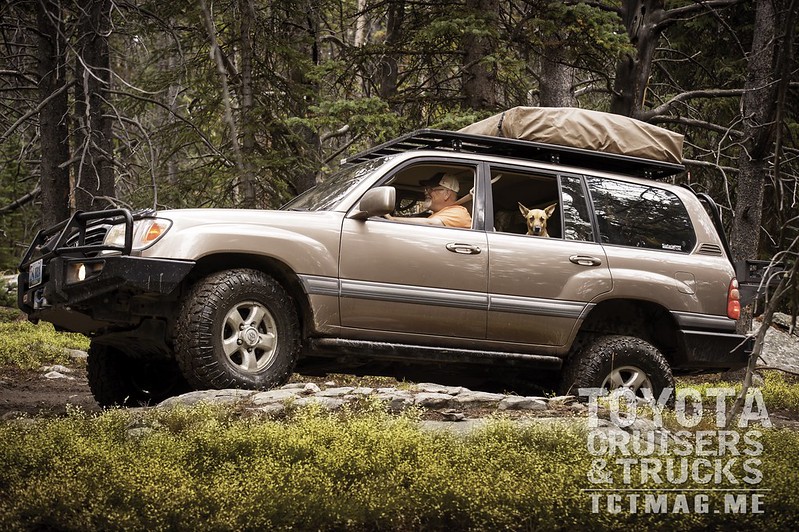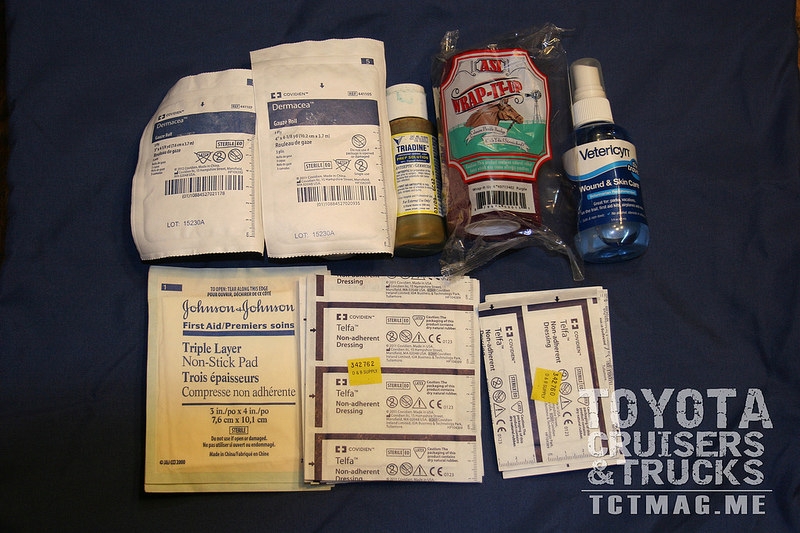The more time we spend with our four-legged travel partners in the outdoors, the more we exposure them to injury. Even a minor pet injury can ruin an adventure and there is nothing worse than seeing your pet limp in pain. I have had to deal with burrs, impaled object, large lacerations, and both heat exposure and borderline hypothermia in my dogs. Even though there are plenty of kits you can buy on-line, I believe in putting your own kit together, simply then you know what is in it. I also think when conditions allow, keep the kit on your dog. This way the kit is within reach of the pup at all times. Second, if for any reason you and your dog are separated, there is a kit handy for the person on hand working with your pup’s injuries.

We have a main kit for the house, one in the rig, and then a small field kit that goes a doggie daypack with smaller quantities that are re-packed and well labeled. I will only list out only the items that goes in our kit that the pups pack with them. We have larger pups, so if your adventure pup is a small breed, well you get to hike with the kit. In other words, no K9 EMT kits on your Mini-Rat Terrier. I will cover what to carry for your pup in your rig later. Something to keep in mind, if out adventuring in hooter temps, then your pup is going to overheat, even if hanging out in your rig.
We highly recommend that you seek out classes that are specific to first-aid for dogs. Get a good solid field manual to keep with the kit. Finally, dogs are different from us two-legged- human medicine unless noted is not for puppy consumption.
BIG DISCLAIMER— THIS IS MY LIST YOU ARE RESPONSIBLE FOR CONSULTING YOUR OWN VET. WE DO NOT ACCEPT ANY RESPONSIBLITY FOR YOUR ACTIONS OR ACTIONS TAKEN ON BEHALF OF THIS LIST
•K9 EMT Gel- This stuff interacts with the wound and maintains much-needed moisture that helps a wound in healing. In addition, it acts as a tissue adhesive to help prevent bacterial infection. It also reduces bleeding and pain. Keep it current though, it will expire.
•Tweezers- When your pup is hurt and you are trying to remove a sliver, they don’t always hold still. One poke with sharp or pointed objects and your pal will not likely lay still for you again. I use flat slant tipped tweezers.
•Scissors- I carry both small dull-ended snips and EMT shears. The small snips are excellent for trimming out goat heads in the fur areas in the paws or burrs on the belly. EMT shears are good for cutting medical tape.
•Tick Removal Tool. These are designed to remove nasty ticks, which, if left in, can lead to infection or worse, diseases like Rocky Mountain Spotted Fever or Lyme’s.
•Cotton balls
•4×4 Gauze Pads and 4” Rolled Gauze. •Hibitane Disinfectant- Learn to use BEFORE you use it
•Saline solution. We live in a sandy area and this is great to get dust and sand out of the eyes. Can also be used to clean wounds. DO NOT USE Contact solution.
•Flush Syringe
•Benadryl- Trigger bit a wasp one day- and I was pretty worried that he was going to swell up and not breathe. A fellow vet-tech of Melissa’s gave him a Benadryl. It reduced the swelling, keeping his airway open...and put him to sleep. Antihistamines can be used to calm itchiness, swelling, and hives caused by insects, but, as with any medication, please with your vet for dosage.
•Antibacterial Wipes or skin soap.
•Bag Balm/Skin & Paw Cream – When feet get torn up. Keep it in a labeled zip-tight bag.
Related Articles
•Rectal Thermometer. A dog’s average is around 101°F.
•Petroleum Jelly. For use with the thermometer...and be sure to scratch your pup’s ears after the intrusion....
•Emergency numbers- I keep three sets of numbers in my kit. My regular vet, the 24-hour vet, ad then when traveling, numbers of vets at each destination.
•Latex gloves
•Emergency contact numbers. The digits for your vet, the closest animal emergency hospital, and the poison control hotline.
•Triangle Bandage to use as a muzzle
•Corn- starch- To stop bleeding of nails (not wounds) that have been broken or cut to the quick.
•Vet Wrap
•Small Space-Blanket (Compact Size)
First Aid Manual for Dogs (small pocket-sized)

More Photos!
[flickr set=72157676909572255]
To get your copy of theSummer 2016 Issue: |








